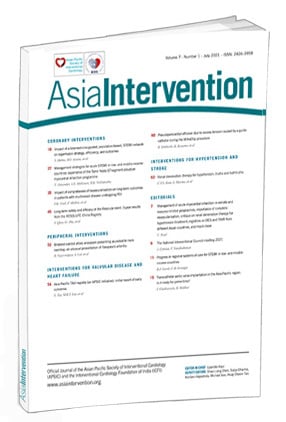The research and development, clinical trials, and commercialisation of transcatheter aortic valve implantation (TAVI) technology were initially limited to the western world, including Canada, Europe and North America. Multiple randomised clinical trials over the last decade have now established TAVI as the standard of care for the treatment of severe symptomatic aortic stenosis, especially of the trileaflet aortic valve, irrespective of surgical risk1,2,3,4,5,6,7,8,9,10. With the cumulative evidence establishing TAVI as a recognised option for the treatment of aortic stenosis, increasing numbers of patients are being treated in the Asia-Pacific region with TAVI technology. There are no randomised clinical trials, and limited registry data11,12, on the performance of TAVI for the treatment of aortic stenosis in the Asia-Pacific region.
This paucity of data on the outcomes of TAVI in the Asia-Pacific region underpins the study by Tay and colleagues in this issue of AsiaIntervention13.
The authors report the clinical outcomes in 1,125 consecutive patients who underwent TAVI between 2009 and 2017 with commercially available transcatheter heart valves in seven medical centres in the Asia-Pacific region. This was a prospective, multicentre registry and clinical data were collected on uniform case report forms. The study endpoints were defined according to the standard updated Valve Academic Research Consortium (VARC-2) and American Society of Echocardiography (ASE) guidelines. Bicuspid aortic valve was present in 6% of the patients and a Society of Thoracic Surgeons (STS) score of less than 4% was noted in 26.4% of the patients. The authors report the following principal findings. (1) The 30-day mortality after TAVI was 2.5%. (2) The incidence of acute procedural complications was relatively low, with acute kidney injury noted in 6.8%, major vascular complications in 5.8%, stroke in 1.2% and major bleeding in 1.2% of the patients. (3) History of stroke prior to the procedure or occurrence of a stroke after the TAVI procedure was independently associated with increased risk of 30-day mortality after TAVI.
It is remarkable that, despite the use of early-generation valves in most patients in this study, the overall 30-day mortality was 2.5%. Even in the patients receiving early-generation transcatheter heart valves, the 30-day mortality was only 3.5%, while the 30-day mortality was 1.1% in patients receiving contemporary transcatheter heart valves. Contemporary transcatheter heart valves were used in less than 25% of the patients (Evolut™ R [Medtronic, Minneapolis, MN, USA] in 13.2% and SAPIEN 3 [Edwards Lifesciences, Irvine, CA, USA] in 8% of the patients). Seventy percent of the TAVI procedures were performed with early-generation transcatheter heart valves (CoreValve® [Medtronic] in 19.5%, SAPIEN XT in 25.8% and SAPIEN in 5.1% [both Edwards Lifesciences]). The incidence of moderate paravalvular regurgitation was high in this study, present in 17% of the patients, probably due to the use of early-generation transcatheter heart valves. An important limitation of this study is the lack of some data, with information on valve type missing in 22% of the patients, valve size missing in 5.8%, and information on vascular access missing in 11.2%.
The transfemoral approach was the predominant approach (91.1%), with the transapical approach being the second most frequently used access. The use of the transapical or transaortic approach for TAVI is expected to fall out of favour, as the incidence of death or stroke was significantly higher at five years in patients undergoing TAVI by the transapical or transaortic approach compared with open heart surgery in the PARTNER intermediate-risk study10. Perhaps subclavian, transcarotid or transcaval vascular access may be the preferred approach in patients undergoing TAVI by an alternative access.
This is the first report of the Asia Pacific Society of Interventional Cardiology (APSIC)-sponsored TAVI registry. Similar prospective registries in other countries have led the way in reporting the national outcomes of TAVI following the commercialisation of TAVI technology, for instance, the Society of Thoracic Surgeons/American College of Cardiology Transcatheter Valve Therapies (STS/ACC TVT) registry14,15 and FRANCE 2 registry16. These national registries have played a critical role in the rational spread of TAVI technology and optimisation of clinical outcomes. These registries provide a platform to assess the outcomes of TAVI overall as well as for individual TAVI programmes, improve understanding of the procedure, identify patients who would benefit or not benefit from this procedure, enable creation of risk models unique to each patient population, and provide valuable information about the type and size of the devices used in the patient population in different geographic regions and the unique challenges faced by different healthcare systems. The authors have taken the lead in the Asia-Pacific region towards establishing such prospective registries to monitor clinical outcomes. While the data presented in this study are not representative of national databases, the reporting centres are centres of excellence in the Asia-Pacific region and provide a benchmark for procedural and clinical outcomes as TAVI technology spreads across the developing world.
Conflict of interest statement
T. Chakravarty is a consultant for Edwards Lifesciences, Medtronic, Abbott and Boston Scientific. R. Makkar is a consultant to and receives research grants from Edwards Lifesciences, Medtronic, Abbott and Boston Scientific.

